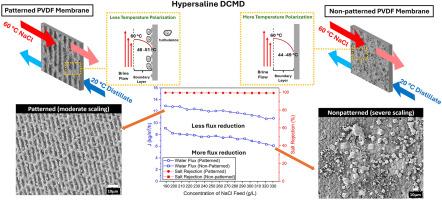The effect of Sharklet patterns on thermal efficiency and salt-scaling resistance of poly (vinylidene fluoride) membranes during direct contact membrane distillation
IF 8.4
1区 工程技术
Q1 ENGINEERING, CHEMICAL
引用次数: 0
Abstract
Membrane distillation (MD) can treat high-salinity brine. However, the system's efficiency is hindered by obstacles, including salt scaling and temperature polarization. When properly implemented, surface patterns can improve the mass and heat transfer in the boundary layer, which leads to higher MD efficiency. In this work, the performance of direct contact membrane distillation (DCMD) using Sharklet-patterned poly (vinylidene fluoride) (PVDF) membranes is investigated. Both non-patterned and patterned PVDF membranes are prepared by lithographically templated thermally induced phase separation (lt-TIPS) process with optimized conditions. Sharklet patterns on the membranes improve the DCMD performance: up to 17 % higher water flux and 35 % increased brine-side heat transfer coefficient. The scaling resistance of the membranes during DCMD is tested by both saturated CaSO4 solution and hypersaline NaCl solutions. Patterned PVDF membranes show an average of 30 % higher water flux and up to 45 % lessened flux decline over time compared with non-patterned membranes when treating high-concentration brines. Post-mortem analysis reveals that Sharklet-patterned membranes display less salt-scaling on surfaces with smaller-sized CaSO4 and NaCl crystals, maintain a relatively cleaner surface, and exhibit better retention of hydrophobicity.

直接接触膜蒸馏过程中鲨鱼鳍图案对聚(偏氟乙烯)膜热效率和抗盐垢能力的影响
膜蒸馏(MD)可以处理高盐度盐水。然而,该系统的效率受到盐结垢和温度极化等障碍的阻碍。如果实施得当,表面图案可以改善边界层的传质和传热,从而提高 MD 效率。在这项工作中,研究了使用鲨鱼鳍图案聚偏二氟乙烯(PVDF)膜的直接接触膜蒸馏(DCMD)的性能。无图案和有图案的聚偏氟乙烯(PVDF)膜都是通过光刻模板热诱导相分离(lt-TIPS)工艺和优化条件制备的。膜上的鲨鱼鳍图案提高了 DCMD 的性能:水通量提高了 17%,盐水侧传热系数提高了 35%。通过饱和 CaSO4 溶液和高盐度 NaCl 溶液测试了膜在 DCMD 过程中的抗结垢能力。在处理高浓度盐水时,与无图案膜相比,有图案的 PVDF 膜平均可提高 30% 的水通量,通量下降的幅度最多可减少 45%。死后分析表明,Sharklet 花纹膜在具有较小尺寸的 CaSO4 和 NaCl 晶体的表面上显示出较少的盐结垢,能保持相对更清洁的表面,并能更好地保持疏水性。
本文章由计算机程序翻译,如有差异,请以英文原文为准。
求助全文
约1分钟内获得全文
求助全文
来源期刊

Journal of Membrane Science
工程技术-高分子科学
CiteScore
17.10
自引率
17.90%
发文量
1031
审稿时长
2.5 months
期刊介绍:
The Journal of Membrane Science is a publication that focuses on membrane systems and is aimed at academic and industrial chemists, chemical engineers, materials scientists, and membranologists. It publishes original research and reviews on various aspects of membrane transport, membrane formation/structure, fouling, module/process design, and processes/applications. The journal primarily focuses on the structure, function, and performance of non-biological membranes but also includes papers that relate to biological membranes. The Journal of Membrane Science publishes Full Text Papers, State-of-the-Art Reviews, Letters to the Editor, and Perspectives.
 求助内容:
求助内容: 应助结果提醒方式:
应助结果提醒方式:


